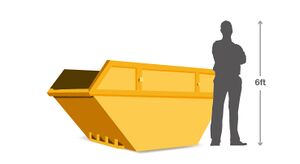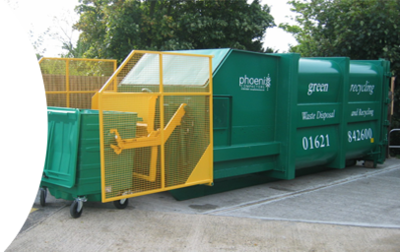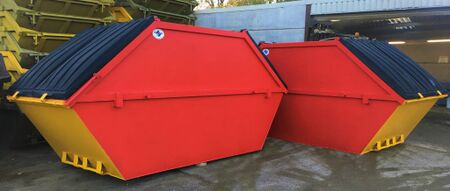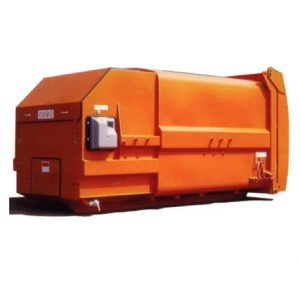Skip
The Skip has been used in the UK primarily for Construction and Demolition Waste works since the 1960s, but these containers are also used as a versatile system for heavier, non-compressible wastes. They are constructed of metal and are delivered, collected, emptied and then returned (or sent to a new waste producer) via a dedicated Skip Lorry or Hooklift Lorry depending on the size of the Skip. This type of skip is distinct from the REL Skip and the FEL Skip which are separately listed on WikiWaste.

Background
The Skip has been used in the UK primarily for Construction and Demolition Waste works since the 1960s, but these containers are also used as a versatile system for heavier, non-compressible wastes. They are constructed of metal and are delivered, collected, emptied and then returned (or sent to a new waste producer) via a dedicated Skip Lorry or Hooklift Lorry depending on the size of the Skip. This type of skip is distinct from the REL Skip and the FEL Skip which is separately listed on WikiWaste.
In the UK the size of a Skip is still traditionally referred to in cubic yards rather than cubic metres (for example an 8 yard skip). There are three broad categories of Skip that relate to their size and the lorry that is used to move them:
- 'Miniskip' - smaller skip up to around 4 cubic yards moved by a small Skip Lorry (3.5 tonne lorry)
- 'Builder's Skip' - medium size skip from 6 to 16 cubic yards moved by a standard Skip Lorry (18 tonne lorry)
- 'Ro-Ro' (shortened version of 'Roll on Roll Off') - large skip from 20 to 40 cubic yards moved by a Hooklift Lorry (18 to 29 tonne lorry)
Skip Types and Sizes
The most common sizes and types of Skip are listed below. The information in the table is a compilation of data in the public domain. The maximum weight in a 'builder's skip' is roughly equivalent to the size in cubic yards (i.e. an 8 cubic yard skip would have a maximum weight of around 8 tonnes).
MiniSkips
The most common sizes are below, but can also include a 3 cubic yard size
| Size (cubic yards) | Size (cubic metres) | Dimensions (ft in) | Dimensions (m) | No. of Black Bags/Bin | Typical Use |
|---|---|---|---|---|---|
| 2 | 1.5 | 2'6"(H) x 4'0"(L) x 3' 0" (W) | 0.76m(H) x 1.2m(L) x 0.91m(W) | 15 to 20 | small house/garden/garage jobs |
| 4 | 3 | 3'2"(H) x 6'0"(L) x 4' 3" (W) | 0.97m(H) x 1.83m(L) x 1.29m(W) | 30 to 40 | larger house/garden/garage jobs |
Builder's Skips
The most common sizes are listed below, but can also include 14 and 16 cubic yard sizes.
| Size (cubic yards) | Size (cubic metres) | Dimensions (ft in) | Dimensions (m) | No. of Black Bags/Bin | Typical Use | Image (MiniSkips and Builder's Skips) |
|---|---|---|---|---|---|---|
| 6 | 4.6 | 4'0"(H) x 8'6"(L) x 5' 0" (W) | 1.22m(H) x 2.6m(L) x 1.52m(W) | 50 to 60 | small builder's works, Soil, Rubble, Hardcore |  |
| 8 | 6 | 4'0"(H) x 12'0"(L) x 5' 6" (W) | 1.22m(H) x 3.66m(L) x 1.68m(W) | 60 to 80 | large builder's works, largest for Soil, Rubble, Hardcore | |
| 12 | 9.2 | 5'6"(H) x 12'2"(L) x 5' 10" (W) | 1.68m(H) x 3.7m(L) x 1.78m(W) | 100 to 120 | large builder's skip and used for bulky materials i.e. Wood Waste |
Ro-Ro
The most common sizes are listed below, but can also include ranges between those shown (for example 35 cubic yards) and a smaller 15 cubic yard.
| Size (cubic yards) | Size (cubic metres) | Dimensions (ft in) | Dimensions (m) | Typical Use | Image (Range of Ro-Ro Skips) |
|---|---|---|---|---|---|
| 20 | 15.3 | 4'3"(H) x 20'0"(L) x 7' 9" (W) | 0.76m(H) x 1.2m(L) x 0.91m(W) | Soil, Rubble, Hardcore |  |
| 30 | 22.9 | 6'2"(H) x 20'0"(L) x 7' 9" (W) | 0.97m(H) x 1.83m(L) x 1.29m(W) | General builder's wastes, Construction and Demolition Waste | |
| 40 | 30.6 | 8'2"(H) x 20'0"(L) x 7' 9" (W) | 0.97m(H) x 1.83m(L) x 1.29m(W) | Lighter builder's waste, Wood Waste, Paper & Card |
Specialty/Adapted Skips
Due to their versatility skips have been adapted for a range of other uses. These broadly include:
| Enclosed Skips | Enclosed Skips (Bring Banks) | Compactor Skips |
|---|---|---|
| Typically 12 and 16 cubic yard skips with lids and lockable doors to handle specialised waste such as Asbestos and Plasterboard | Typically 16 cubic yard and 30 cubic yard skips with lids and holes in the sides to deposit Glass, Paper & Card, and Plastic often as part of a Bring Bank or HWRC facility | Typically 30 cubic yard skips, a fully enclosed skip that mounts onto a Static Compactor for waste and/or other materials such as Paper & Card or Garden Waste to be compacted into the container for subsequent transportation. An alternative configuration is for the compactor to be part of the skip construction to make it fully portable. |
 |
 |
 |
 |
 |
 |
